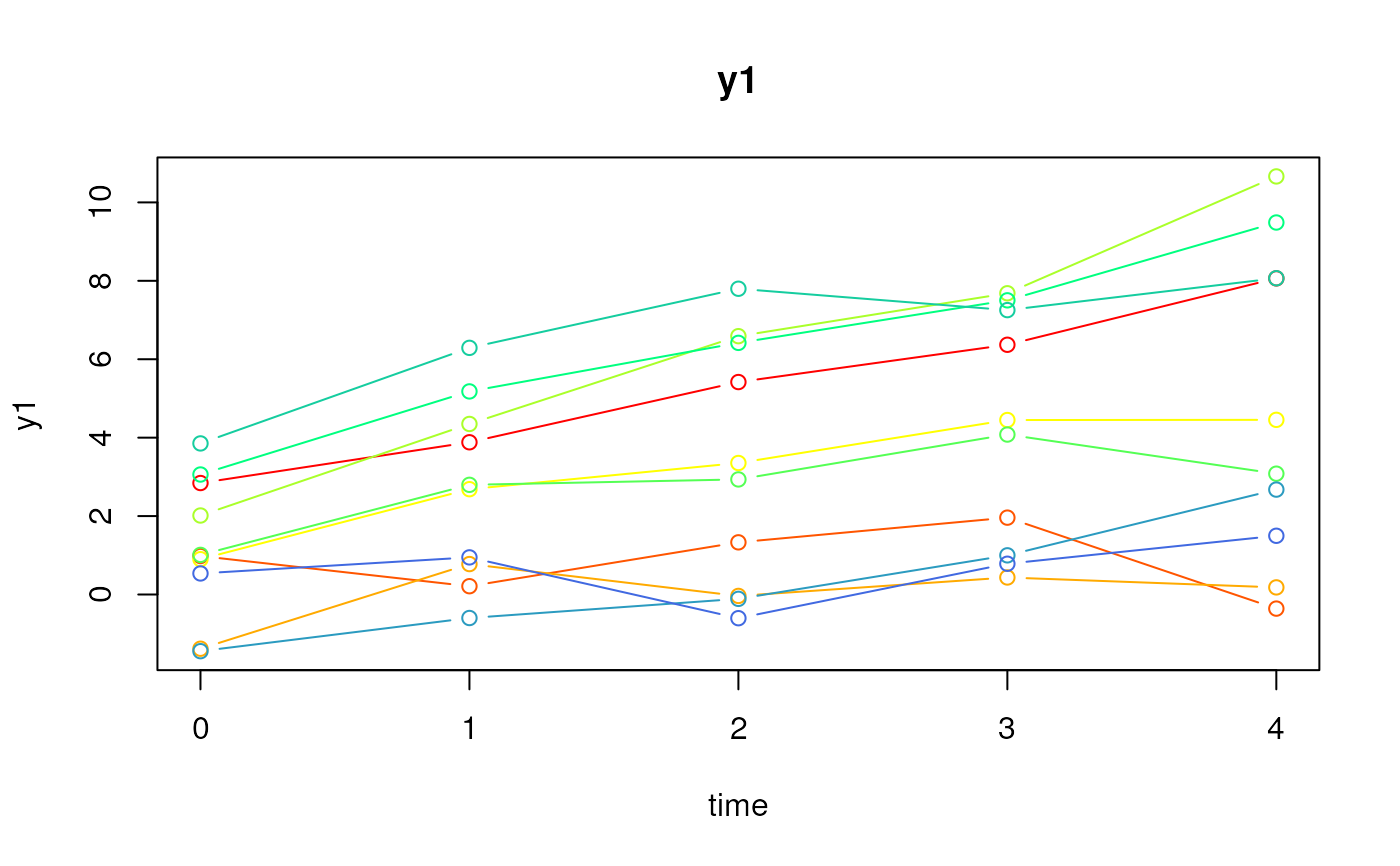Simulate Data from the Linear Growth Curve Model (Individual-Varying Parameters)
Source:R/simStateSpace-sim-ssm-lin-growth-i-vary.R
SimSSMLinGrowthIVary.RdThis function simulates data from the linear growth curve model. It assumes that the parameters can vary across individuals.
Usage
SimSSMLinGrowthIVary(
n,
time,
mu0,
sigma0_l,
theta_l,
type = 0,
x = NULL,
gamma = NULL,
kappa = NULL
)Arguments
- n
Positive integer. Number of individuals.
- time
Positive integer. Number of time points.
- mu0
A list of numeric vectors. Each element of the list is a vector of length two. The first element is the mean of the intercept, and the second element is the mean of the slope.
- sigma0_l
A list of numeric matrices. Each element of the list is the Cholesky factorization (
t(chol(sigma0))) of the covariance matrix of the intercept and the slope.- theta_l
A list numeric values. Each element of the list is the square root of the common measurement error variance.
- type
Integer. State space model type. See Details in
SimSSMLinGrowth()for more information.- x
List. Each element of the list is a matrix of covariates for each individual
iinn. The number of columns in each matrix should be equal totime.- gamma
List of numeric matrices. Each element of the list is the matrix linking the covariates to the latent variables at current time point (\(\boldsymbol{\Gamma}\)).
- kappa
List of numeric matrices. Each element of the list is the matrix linking the covariates to the observed variables at current time point (\(\boldsymbol{\kappa}\)).
Value
Returns an object of class simstatespace
which is a list with the following elements:
call: Function call.args: Function arguments.data: Generated data which is a list of lengthn. Each element ofdatais a list with the following elements:id: A vector of ID numbers with lengthl, wherelis the value of the function argumenttime.time: A vector time points of lengthl.y: Albykmatrix of values for the manifest variables.eta: Albypmatrix of values for the latent variables.x: Albyjmatrix of values for the covariates (when covariates are included).
fun: Function used.
Details
Parameters can vary across individuals
by providing a list of parameter values.
If the length of any of the parameters
(mu0,
sigma0,
mu,
theta_l,
gamma, or
kappa)
is less the n,
the function will cycle through the available values.
References
Chow, S.-M., Ho, M. R., Hamaker, E. L., & Dolan, C. V. (2010). Equivalence and differences between structural equation modeling and state-space modeling techniques. Structural Equation Modeling: A Multidisciplinary Journal, 17(2), 303–332. doi:10.1080/10705511003661553
See also
Other Simulation of State Space Models Data Functions:
LinSDE2SSM(),
LinSDECovEta(),
LinSDECovY(),
LinSDEMeanEta(),
LinSDEMeanY(),
ProjectToHurwitz(),
ProjectToStability(),
SSMCovEta(),
SSMCovY(),
SSMMeanEta(),
SSMMeanY(),
SimAlphaN(),
SimBetaN(),
SimBetaN2(),
SimBetaNCovariate(),
SimCovDiagN(),
SimCovN(),
SimIotaN(),
SimNuN(),
SimPhiN(),
SimPhiN2(),
SimPhiNCovariate(),
SimSSMFixed(),
SimSSMIVary(),
SimSSMLinGrowth(),
SimSSMLinSDEFixed(),
SimSSMLinSDEIVary(),
SimSSMOUFixed(),
SimSSMOUIVary(),
SimSSMVARFixed(),
SimSSMVARIVary(),
SpectralRadius(),
TestPhi(),
TestPhiHurwitz(),
TestStability(),
TestStationarity()
Other Simulation of State Space Models Data Functions:
LinSDE2SSM(),
LinSDECovEta(),
LinSDECovY(),
LinSDEMeanEta(),
LinSDEMeanY(),
ProjectToHurwitz(),
ProjectToStability(),
SSMCovEta(),
SSMCovY(),
SSMMeanEta(),
SSMMeanY(),
SimAlphaN(),
SimBetaN(),
SimBetaN2(),
SimBetaNCovariate(),
SimCovDiagN(),
SimCovN(),
SimIotaN(),
SimNuN(),
SimPhiN(),
SimPhiN2(),
SimPhiNCovariate(),
SimSSMFixed(),
SimSSMIVary(),
SimSSMLinGrowth(),
SimSSMLinSDEFixed(),
SimSSMLinSDEIVary(),
SimSSMOUFixed(),
SimSSMOUIVary(),
SimSSMVARFixed(),
SimSSMVARIVary(),
SpectralRadius(),
TestPhi(),
TestPhiHurwitz(),
TestStability(),
TestStationarity()
Examples
# prepare parameters
# In this example, the mean vector of the intercept and slope vary.
# Specifically,
# there are two sets of values representing two latent classes.
set.seed(42)
## number of individuals
n <- 10
## time points
time <- 5
## dynamic structure
p <- 2
mu0_1 <- c(0.615, 1.006) # lower starting point, higher growth
mu0_2 <- c(1.000, 0.500) # higher starting point, lower growth
mu0 <- list(mu0_1, mu0_2)
sigma0 <- matrix(
data = c(
1.932,
0.618,
0.618,
0.587
),
nrow = p
)
sigma0_l <- list(t(chol(sigma0)))
## measurement model
k <- 1
theta <- 0.50
theta_l <- list(sqrt(theta))
## covariates
j <- 2
x <- lapply(
X = seq_len(n),
FUN = function(i) {
matrix(
data = stats::rnorm(n = time * j),
nrow = j,
ncol = time
)
}
)
gamma <- list(
diag(x = 0.10, nrow = p, ncol = j)
)
kappa <- list(
diag(x = 0.10, nrow = k, ncol = j)
)
# Type 0
ssm <- SimSSMLinGrowthIVary(
n = n,
time = time,
mu0 = mu0,
sigma0_l = sigma0_l,
theta_l = theta_l,
type = 0
)
plot(ssm)
 # Type 1
ssm <- SimSSMLinGrowthIVary(
n = n,
time = time,
mu0 = mu0,
sigma0_l = sigma0_l,
theta_l = theta_l,
type = 1,
x = x,
gamma = gamma
)
plot(ssm)
# Type 1
ssm <- SimSSMLinGrowthIVary(
n = n,
time = time,
mu0 = mu0,
sigma0_l = sigma0_l,
theta_l = theta_l,
type = 1,
x = x,
gamma = gamma
)
plot(ssm)
 # Type 2
ssm <- SimSSMLinGrowthIVary(
n = n,
time = time,
mu0 = mu0,
sigma0_l = sigma0_l,
theta_l = theta_l,
type = 2,
x = x,
gamma = gamma,
kappa = kappa
)
plot(ssm)
# Type 2
ssm <- SimSSMLinGrowthIVary(
n = n,
time = time,
mu0 = mu0,
sigma0_l = sigma0_l,
theta_l = theta_l,
type = 2,
x = x,
gamma = gamma,
kappa = kappa
)
plot(ssm)
